Nursing Action Plans: Improving Nursing Practice in Clinical Settings
VerifiedAdded on 2022/12/12
|15
|3214
|95
Homework Assignment
AI Summary
This document presents three nursing action plans developed by a student to improve their clinical practice, specifically addressing the nursing standards of practice. The first action plan focuses on enhancing therapeutic and professional relationships, outlining strategies such as fostering collegial generosity, practicing effective communication, and promoting empathy. The second plan emphasizes comprehensive assessment, detailing the importance of gathering relevant patient data, utilizing various evaluation techniques, and ensuring thorough documentation. The third action plan centers on providing safe, appropriate, and responsive quality nursing practice, highlighting the need for error-free service, adherence to guidelines, and regular training. Each plan includes specific goals (using the SMART acronym), measurable objectives, achievable strategies, relevant activities, and identified resources to support implementation and improvement. The plans are supported by references to evidence-based literature and clinical guidelines.

Running Head: Nursing Action plan
Nursing Action plan
Student Name:
Student ID:
Lecturer Name:
Unit Name:
Code:
Words: 2082
1 | P a g e
Nursing Action plan
Student Name:
Student ID:
Lecturer Name:
Unit Name:
Code:
Words: 2082
1 | P a g e
Paraphrase This Document
Need a fresh take? Get an instant paraphrase of this document with our AI Paraphraser
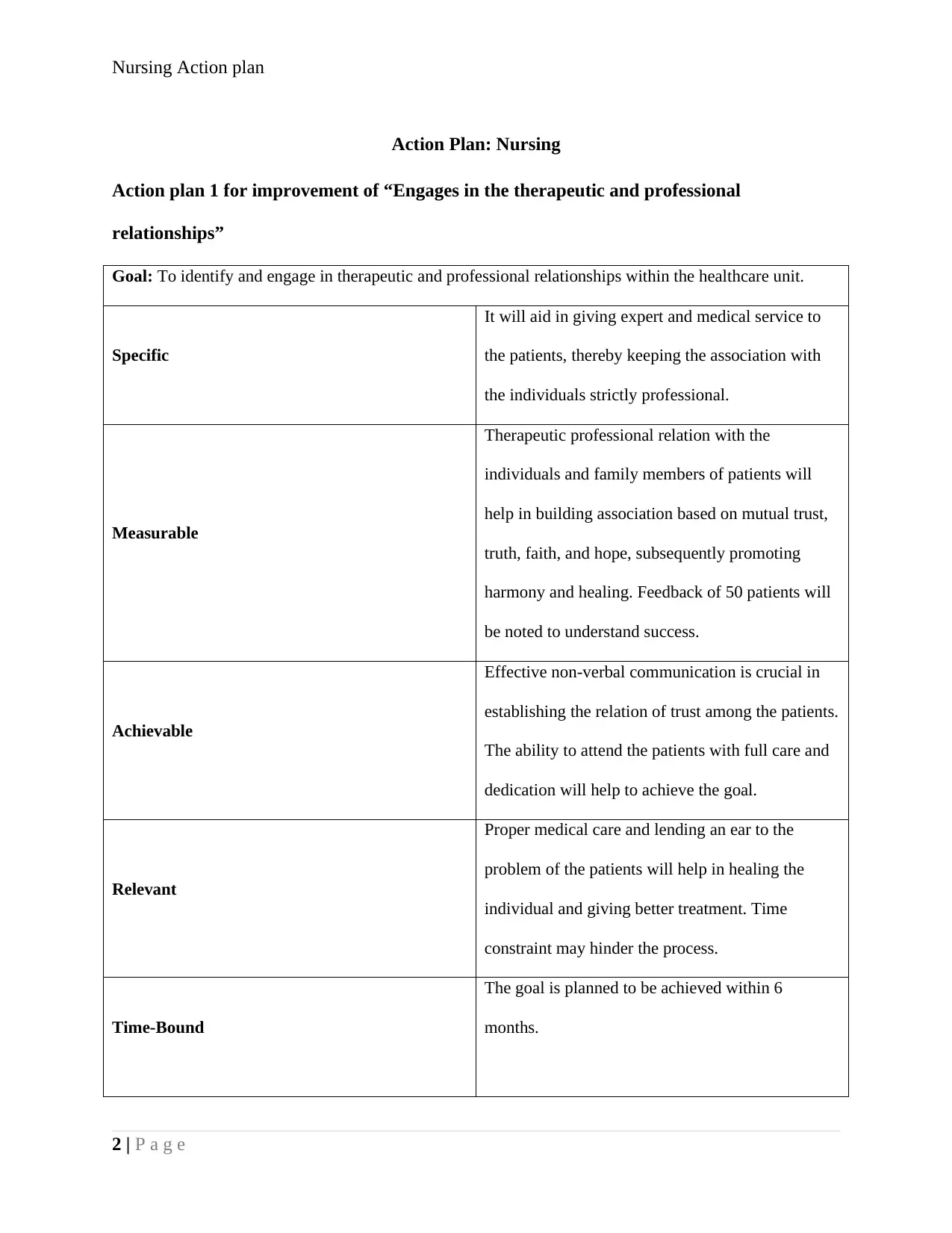
Nursing Action plan
Action Plan: Nursing
Action plan 1 for improvement of “Engages in the therapeutic and professional
relationships”
Goal: To identify and engage in therapeutic and professional relationships within the healthcare unit.
Specific
It will aid in giving expert and medical service to
the patients, thereby keeping the association with
the individuals strictly professional.
Measurable
Therapeutic professional relation with the
individuals and family members of patients will
help in building association based on mutual trust,
truth, faith, and hope, subsequently promoting
harmony and healing. Feedback of 50 patients will
be noted to understand success.
Achievable
Effective non-verbal communication is crucial in
establishing the relation of trust among the patients.
The ability to attend the patients with full care and
dedication will help to achieve the goal.
Relevant
Proper medical care and lending an ear to the
problem of the patients will help in healing the
individual and giving better treatment. Time
constraint may hinder the process.
Time-Bound
The goal is planned to be achieved within 6
months.
2 | P a g e
Action Plan: Nursing
Action plan 1 for improvement of “Engages in the therapeutic and professional
relationships”
Goal: To identify and engage in therapeutic and professional relationships within the healthcare unit.
Specific
It will aid in giving expert and medical service to
the patients, thereby keeping the association with
the individuals strictly professional.
Measurable
Therapeutic professional relation with the
individuals and family members of patients will
help in building association based on mutual trust,
truth, faith, and hope, subsequently promoting
harmony and healing. Feedback of 50 patients will
be noted to understand success.
Achievable
Effective non-verbal communication is crucial in
establishing the relation of trust among the patients.
The ability to attend the patients with full care and
dedication will help to achieve the goal.
Relevant
Proper medical care and lending an ear to the
problem of the patients will help in healing the
individual and giving better treatment. Time
constraint may hinder the process.
Time-Bound
The goal is planned to be achieved within 6
months.
2 | P a g e
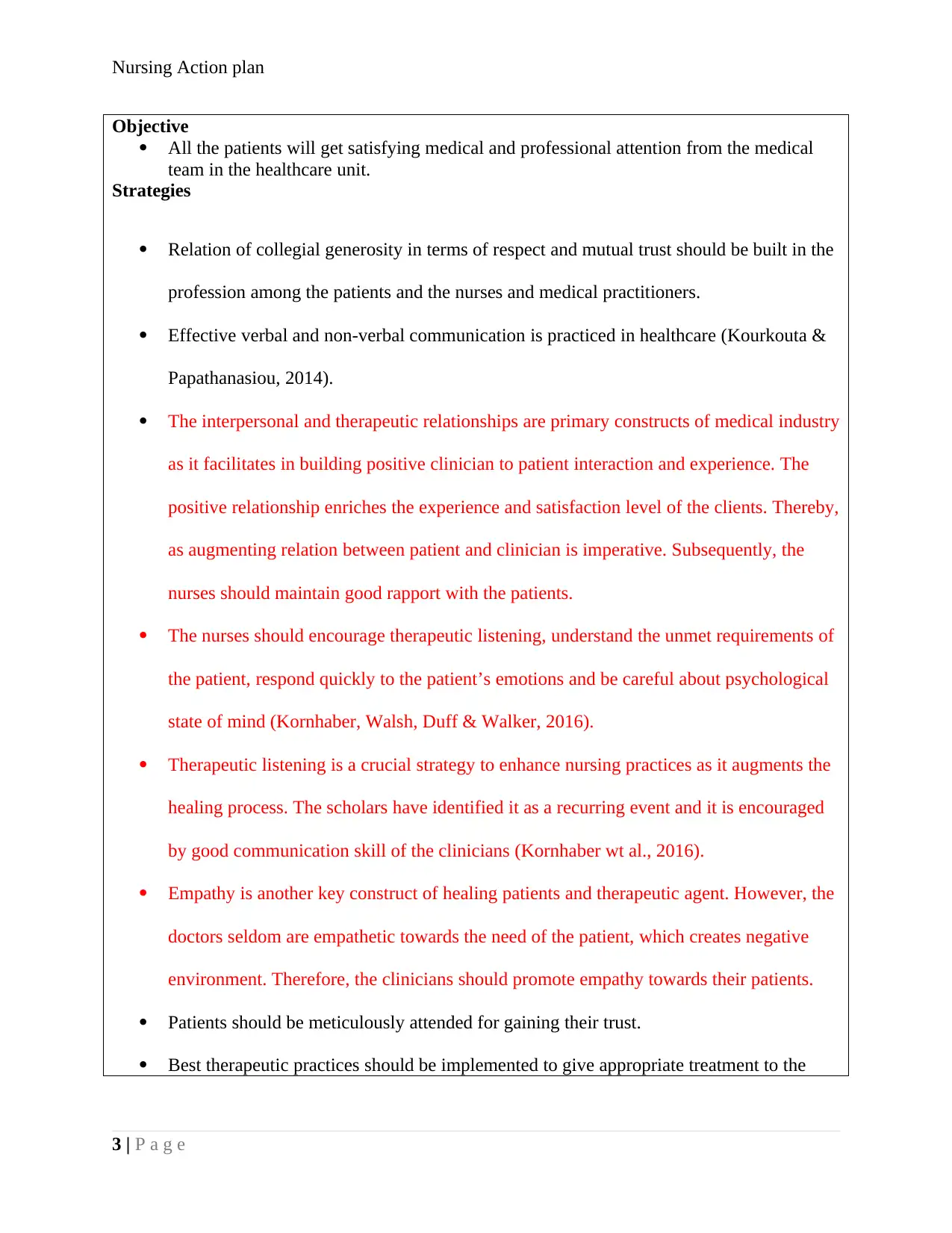
Nursing Action plan
Objective
All the patients will get satisfying medical and professional attention from the medical
team in the healthcare unit.
Strategies
Relation of collegial generosity in terms of respect and mutual trust should be built in the
profession among the patients and the nurses and medical practitioners.
Effective verbal and non-verbal communication is practiced in healthcare (Kourkouta &
Papathanasiou, 2014).
The interpersonal and therapeutic relationships are primary constructs of medical industry
as it facilitates in building positive clinician to patient interaction and experience. The
positive relationship enriches the experience and satisfaction level of the clients. Thereby,
as augmenting relation between patient and clinician is imperative. Subsequently, the
nurses should maintain good rapport with the patients.
The nurses should encourage therapeutic listening, understand the unmet requirements of
the patient, respond quickly to the patient’s emotions and be careful about psychological
state of mind (Kornhaber, Walsh, Duff & Walker, 2016).
Therapeutic listening is a crucial strategy to enhance nursing practices as it augments the
healing process. The scholars have identified it as a recurring event and it is encouraged
by good communication skill of the clinicians (Kornhaber wt al., 2016).
Empathy is another key construct of healing patients and therapeutic agent. However, the
doctors seldom are empathetic towards the need of the patient, which creates negative
environment. Therefore, the clinicians should promote empathy towards their patients.
Patients should be meticulously attended for gaining their trust.
Best therapeutic practices should be implemented to give appropriate treatment to the
3 | P a g e
Objective
All the patients will get satisfying medical and professional attention from the medical
team in the healthcare unit.
Strategies
Relation of collegial generosity in terms of respect and mutual trust should be built in the
profession among the patients and the nurses and medical practitioners.
Effective verbal and non-verbal communication is practiced in healthcare (Kourkouta &
Papathanasiou, 2014).
The interpersonal and therapeutic relationships are primary constructs of medical industry
as it facilitates in building positive clinician to patient interaction and experience. The
positive relationship enriches the experience and satisfaction level of the clients. Thereby,
as augmenting relation between patient and clinician is imperative. Subsequently, the
nurses should maintain good rapport with the patients.
The nurses should encourage therapeutic listening, understand the unmet requirements of
the patient, respond quickly to the patient’s emotions and be careful about psychological
state of mind (Kornhaber, Walsh, Duff & Walker, 2016).
Therapeutic listening is a crucial strategy to enhance nursing practices as it augments the
healing process. The scholars have identified it as a recurring event and it is encouraged
by good communication skill of the clinicians (Kornhaber wt al., 2016).
Empathy is another key construct of healing patients and therapeutic agent. However, the
doctors seldom are empathetic towards the need of the patient, which creates negative
environment. Therefore, the clinicians should promote empathy towards their patients.
Patients should be meticulously attended for gaining their trust.
Best therapeutic practices should be implemented to give appropriate treatment to the
3 | P a g e
⊘ This is a preview!⊘
Do you want full access?
Subscribe today to unlock all pages.

Trusted by 1+ million students worldwide

Nursing Action plan
patients (Felton & Royal, 2015).
It should be ensured that the complete information about the patient is available to the
nurses attending them, in order to identify accurate health problem and give relevant
treatment to the individual.
Activities
Give recognition to the individuals that the persons are experts in their personal life.
Give value to their identification of health issues and problems faced by the individuals.
Effectively communicates with the patients and offers due respect without offending their
religion, culture, rights, beliefs, opinions, and dignity.
The health care practitioners give support and channelize the individuals to the
appropriate resources to enhance their health and minimize issues.
The nurses build distinct yet close professional relationships with the patients or their
family that is quite different from personal association (Panunto & Guirardello, 2013).
Close and professional liaison helps in augmenting mutual trust for each other.
The health care people advocate on behalf of the patients or their families to protect their
legal capacity and personal autonomy.
The individuals participate to implement collaborative practices.
It actively works to nurture the culture of safety and continuous learning (Seidl &
Newhouse, 2012).
It engages the individuals from the medical field and expert health professionals in order
to share knowledge and updated information that helps to support and treat persons.
It promotes and spreads notifiable improvements in the medical sector.
Improved health outcomes are achieved through proper coordination, supervision,
4 | P a g e
patients (Felton & Royal, 2015).
It should be ensured that the complete information about the patient is available to the
nurses attending them, in order to identify accurate health problem and give relevant
treatment to the individual.
Activities
Give recognition to the individuals that the persons are experts in their personal life.
Give value to their identification of health issues and problems faced by the individuals.
Effectively communicates with the patients and offers due respect without offending their
religion, culture, rights, beliefs, opinions, and dignity.
The health care practitioners give support and channelize the individuals to the
appropriate resources to enhance their health and minimize issues.
The nurses build distinct yet close professional relationships with the patients or their
family that is quite different from personal association (Panunto & Guirardello, 2013).
Close and professional liaison helps in augmenting mutual trust for each other.
The health care people advocate on behalf of the patients or their families to protect their
legal capacity and personal autonomy.
The individuals participate to implement collaborative practices.
It actively works to nurture the culture of safety and continuous learning (Seidl &
Newhouse, 2012).
It engages the individuals from the medical field and expert health professionals in order
to share knowledge and updated information that helps to support and treat persons.
It promotes and spreads notifiable improvements in the medical sector.
Improved health outcomes are achieved through proper coordination, supervision,
4 | P a g e
Paraphrase This Document
Need a fresh take? Get an instant paraphrase of this document with our AI Paraphraser

Nursing Action plan
delegation, and consultation with medical experts (Zaccagnini & Pechacek, 2019).
Resources and Support
Clinical guidelines are available online on the hospital website that guides the necessary
steps to be followed.
The textbooks on nursing practices containing a large number of guidelines for
developing effective therapeutic and professional practices.
There are numerous websites that are monitored by health experts and consultants who
guide and provide updated information about different and improved practices.
Patient feedback also helps in identifying the gap areas in the behavior of the nurses and
help in improving it.
Individual hospital manuals offer specific regulations to its staff for augmenting their
behavioral approach and enhance professional relationship (Seidl & Newhouse, 2012).
Reference list
Felton, A., & Royal, J. (2015). Skills for nursing practice: Development of clinical skills in pre-
registration nurse education. Nurse education in practice, 15(1), 38-43.
Kornhaber, R., Walsh, K., Duff, J., & Walker, K. (2016). Enhancing adult therapeutic
interpersonal relationships in the acute health care setting: An integrative review. Journal
of multidisciplinary healthcare, 9, 537.
Kourkouta, L., & Papathanasiou, I. V. (2014). Communication in nursing practice. Materia
socio-medica, 26(1), 65.
Panunto, M. R., & Guirardello, E. D. B. (2013). Professional nursing practice: environment and
5 | P a g e
delegation, and consultation with medical experts (Zaccagnini & Pechacek, 2019).
Resources and Support
Clinical guidelines are available online on the hospital website that guides the necessary
steps to be followed.
The textbooks on nursing practices containing a large number of guidelines for
developing effective therapeutic and professional practices.
There are numerous websites that are monitored by health experts and consultants who
guide and provide updated information about different and improved practices.
Patient feedback also helps in identifying the gap areas in the behavior of the nurses and
help in improving it.
Individual hospital manuals offer specific regulations to its staff for augmenting their
behavioral approach and enhance professional relationship (Seidl & Newhouse, 2012).
Reference list
Felton, A., & Royal, J. (2015). Skills for nursing practice: Development of clinical skills in pre-
registration nurse education. Nurse education in practice, 15(1), 38-43.
Kornhaber, R., Walsh, K., Duff, J., & Walker, K. (2016). Enhancing adult therapeutic
interpersonal relationships in the acute health care setting: An integrative review. Journal
of multidisciplinary healthcare, 9, 537.
Kourkouta, L., & Papathanasiou, I. V. (2014). Communication in nursing practice. Materia
socio-medica, 26(1), 65.
Panunto, M. R., & Guirardello, E. D. B. (2013). Professional nursing practice: environment and
5 | P a g e

Nursing Action plan
emotional exhaustion among intensive care nurses. Revista latino-americana de
enfermagem, 21(3), 765-772.
Seidl, K. L., & Newhouse, R. P. (2012). The intersection of evidence-based practice with 5
quality improvement methodologies. JONA: The Journal of Nursing Administration,
42(6), 299-304.
Zaccagnini, M., & Pechacek, J. M. (2019). The doctor of nursing practice essentials: A new
model for advanced practice nursing. US: Jones & Bartlett Publishers.
Action plan 2 for improvement of “Comprehensively conducts assessment”
Goal: To conduct the assessments comprehensively and extensively.
Specific
All patients should be given a timely and
appropriate nursing assessment.
Measurable
In the medical situation, regular and extensive
nursing assessment is required for further planning
for provision of the patient and needs a consultation
with the family members. Every week 25 patients
will be assessed.
Achievable
Complete database and information of the patients
have to be collected and recorded as patient history,
general assessment, etc.
Relevant Assessment will help in planning the treatment to
be given for proper healing. During high demand
season, an inadequate number of nurses may affect
6 | P a g e
emotional exhaustion among intensive care nurses. Revista latino-americana de
enfermagem, 21(3), 765-772.
Seidl, K. L., & Newhouse, R. P. (2012). The intersection of evidence-based practice with 5
quality improvement methodologies. JONA: The Journal of Nursing Administration,
42(6), 299-304.
Zaccagnini, M., & Pechacek, J. M. (2019). The doctor of nursing practice essentials: A new
model for advanced practice nursing. US: Jones & Bartlett Publishers.
Action plan 2 for improvement of “Comprehensively conducts assessment”
Goal: To conduct the assessments comprehensively and extensively.
Specific
All patients should be given a timely and
appropriate nursing assessment.
Measurable
In the medical situation, regular and extensive
nursing assessment is required for further planning
for provision of the patient and needs a consultation
with the family members. Every week 25 patients
will be assessed.
Achievable
Complete database and information of the patients
have to be collected and recorded as patient history,
general assessment, etc.
Relevant Assessment will help in planning the treatment to
be given for proper healing. During high demand
season, an inadequate number of nurses may affect
6 | P a g e
⊘ This is a preview!⊘
Do you want full access?
Subscribe today to unlock all pages.

Trusted by 1+ million students worldwide
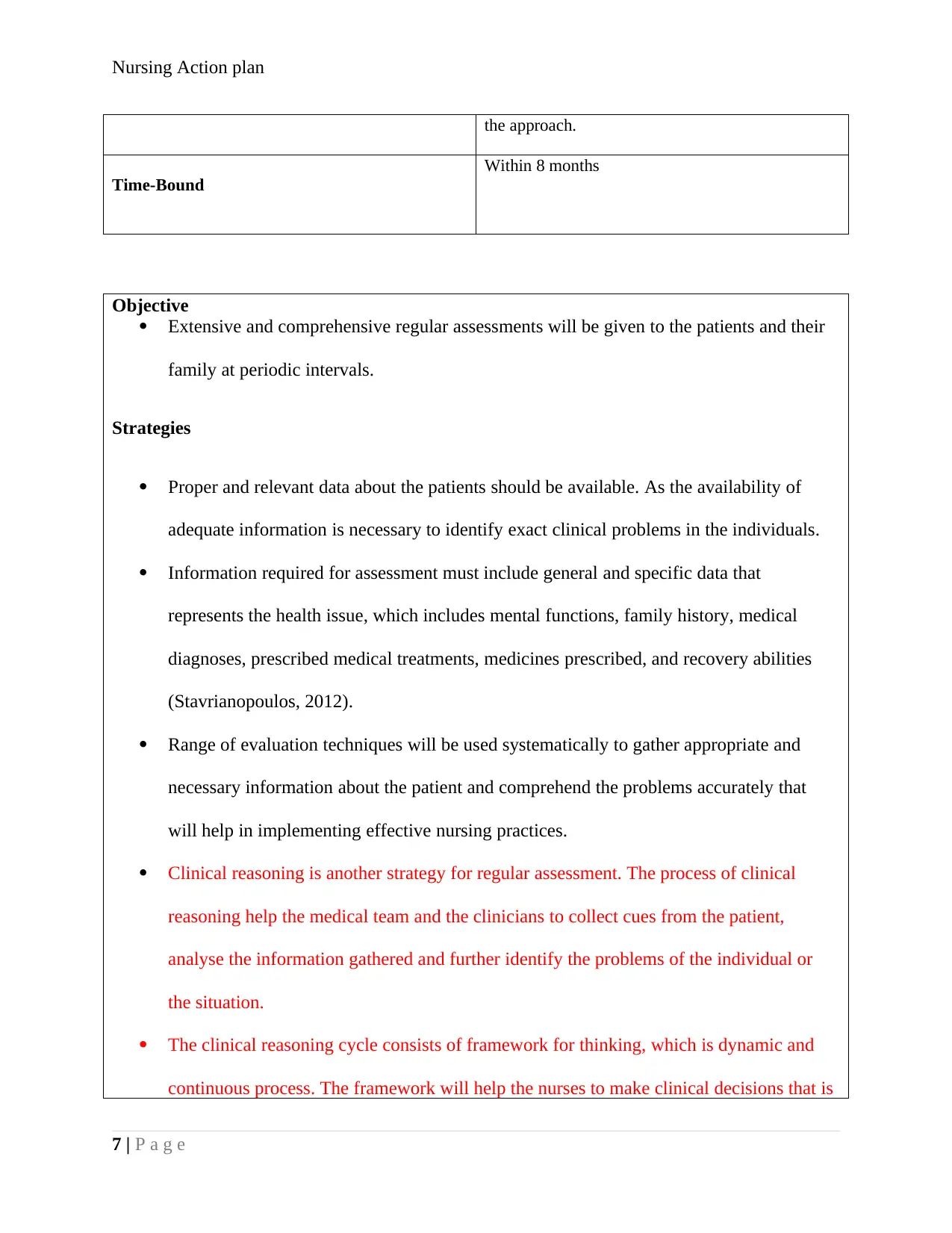
Nursing Action plan
the approach.
Time-Bound
Within 8 months
Objective
Extensive and comprehensive regular assessments will be given to the patients and their
family at periodic intervals.
Strategies
Proper and relevant data about the patients should be available. As the availability of
adequate information is necessary to identify exact clinical problems in the individuals.
Information required for assessment must include general and specific data that
represents the health issue, which includes mental functions, family history, medical
diagnoses, prescribed medical treatments, medicines prescribed, and recovery abilities
(Stavrianopoulos, 2012).
Range of evaluation techniques will be used systematically to gather appropriate and
necessary information about the patient and comprehend the problems accurately that
will help in implementing effective nursing practices.
Clinical reasoning is another strategy for regular assessment. The process of clinical
reasoning help the medical team and the clinicians to collect cues from the patient,
analyse the information gathered and further identify the problems of the individual or
the situation.
The clinical reasoning cycle consists of framework for thinking, which is dynamic and
continuous process. The framework will help the nurses to make clinical decisions that is
7 | P a g e
the approach.
Time-Bound
Within 8 months
Objective
Extensive and comprehensive regular assessments will be given to the patients and their
family at periodic intervals.
Strategies
Proper and relevant data about the patients should be available. As the availability of
adequate information is necessary to identify exact clinical problems in the individuals.
Information required for assessment must include general and specific data that
represents the health issue, which includes mental functions, family history, medical
diagnoses, prescribed medical treatments, medicines prescribed, and recovery abilities
(Stavrianopoulos, 2012).
Range of evaluation techniques will be used systematically to gather appropriate and
necessary information about the patient and comprehend the problems accurately that
will help in implementing effective nursing practices.
Clinical reasoning is another strategy for regular assessment. The process of clinical
reasoning help the medical team and the clinicians to collect cues from the patient,
analyse the information gathered and further identify the problems of the individual or
the situation.
The clinical reasoning cycle consists of framework for thinking, which is dynamic and
continuous process. The framework will help the nurses to make clinical decisions that is
7 | P a g e
Paraphrase This Document
Need a fresh take? Get an instant paraphrase of this document with our AI Paraphraser
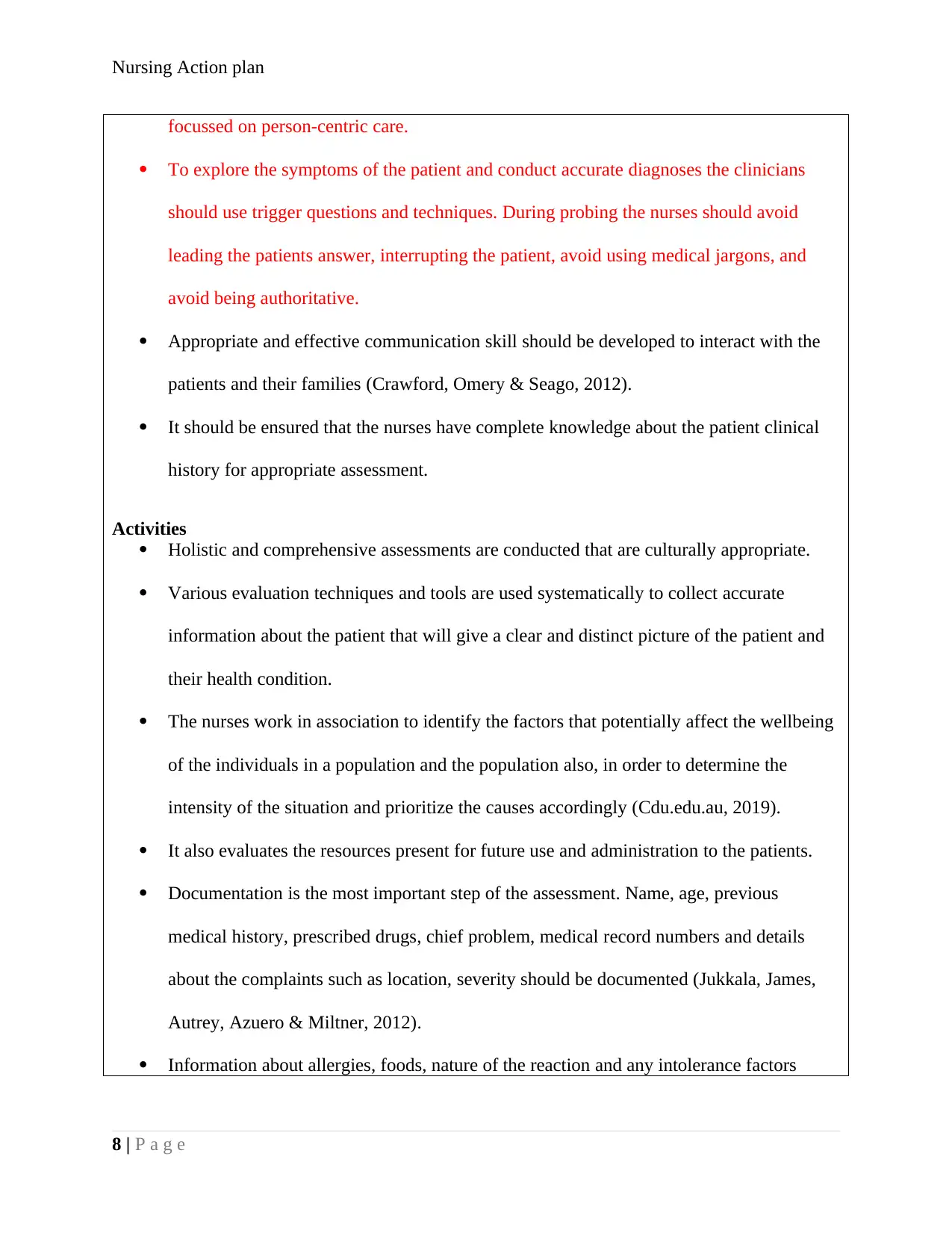
Nursing Action plan
focussed on person-centric care.
To explore the symptoms of the patient and conduct accurate diagnoses the clinicians
should use trigger questions and techniques. During probing the nurses should avoid
leading the patients answer, interrupting the patient, avoid using medical jargons, and
avoid being authoritative.
Appropriate and effective communication skill should be developed to interact with the
patients and their families (Crawford, Omery & Seago, 2012).
It should be ensured that the nurses have complete knowledge about the patient clinical
history for appropriate assessment.
Activities
Holistic and comprehensive assessments are conducted that are culturally appropriate.
Various evaluation techniques and tools are used systematically to collect accurate
information about the patient that will give a clear and distinct picture of the patient and
their health condition.
The nurses work in association to identify the factors that potentially affect the wellbeing
of the individuals in a population and the population also, in order to determine the
intensity of the situation and prioritize the causes accordingly (Cdu.edu.au, 2019).
It also evaluates the resources present for future use and administration to the patients.
Documentation is the most important step of the assessment. Name, age, previous
medical history, prescribed drugs, chief problem, medical record numbers and details
about the complaints such as location, severity should be documented (Jukkala, James,
Autrey, Azuero & Miltner, 2012).
Information about allergies, foods, nature of the reaction and any intolerance factors
8 | P a g e
focussed on person-centric care.
To explore the symptoms of the patient and conduct accurate diagnoses the clinicians
should use trigger questions and techniques. During probing the nurses should avoid
leading the patients answer, interrupting the patient, avoid using medical jargons, and
avoid being authoritative.
Appropriate and effective communication skill should be developed to interact with the
patients and their families (Crawford, Omery & Seago, 2012).
It should be ensured that the nurses have complete knowledge about the patient clinical
history for appropriate assessment.
Activities
Holistic and comprehensive assessments are conducted that are culturally appropriate.
Various evaluation techniques and tools are used systematically to collect accurate
information about the patient that will give a clear and distinct picture of the patient and
their health condition.
The nurses work in association to identify the factors that potentially affect the wellbeing
of the individuals in a population and the population also, in order to determine the
intensity of the situation and prioritize the causes accordingly (Cdu.edu.au, 2019).
It also evaluates the resources present for future use and administration to the patients.
Documentation is the most important step of the assessment. Name, age, previous
medical history, prescribed drugs, chief problem, medical record numbers and details
about the complaints such as location, severity should be documented (Jukkala, James,
Autrey, Azuero & Miltner, 2012).
Information about allergies, foods, nature of the reaction and any intolerance factors
8 | P a g e
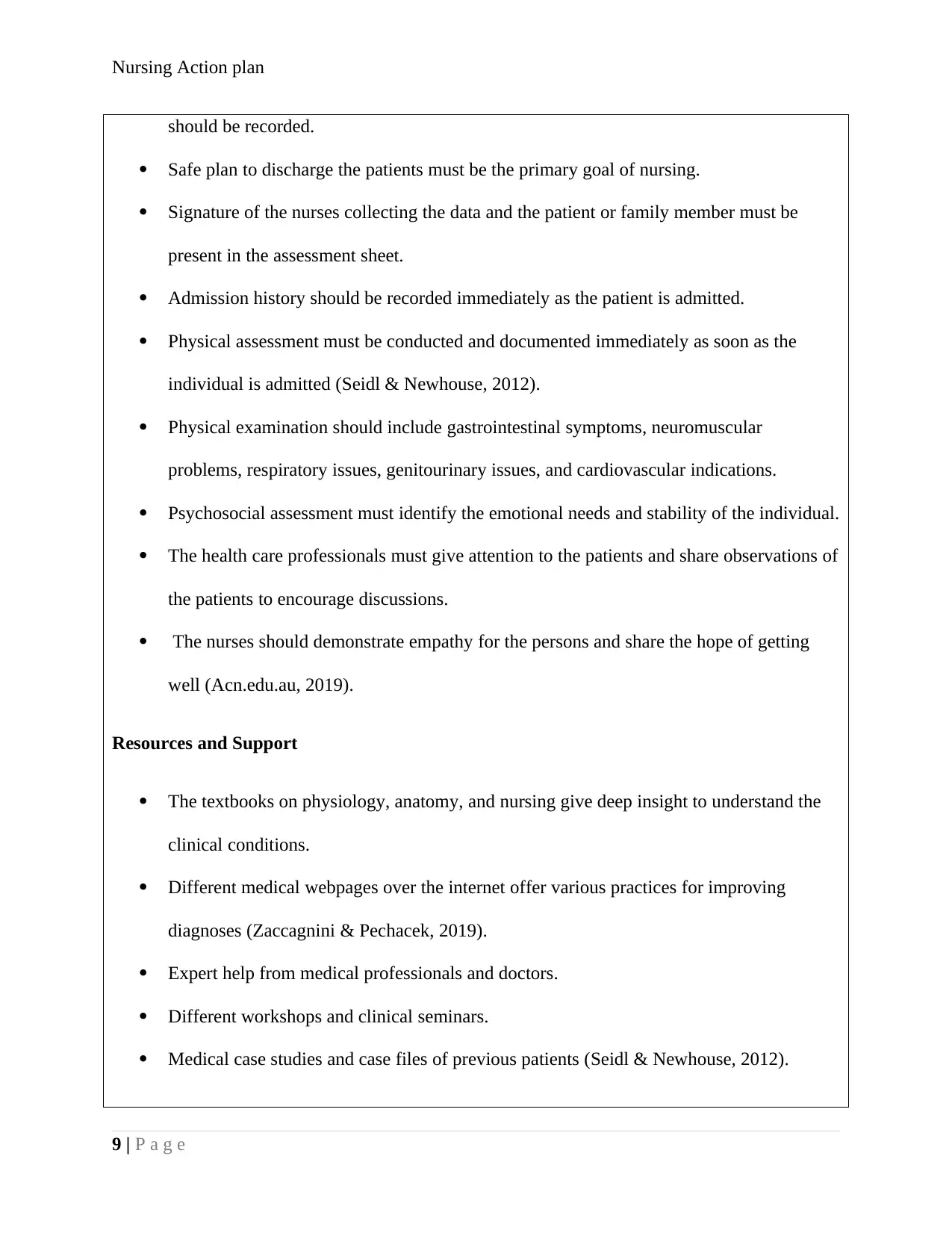
Nursing Action plan
should be recorded.
Safe plan to discharge the patients must be the primary goal of nursing.
Signature of the nurses collecting the data and the patient or family member must be
present in the assessment sheet.
Admission history should be recorded immediately as the patient is admitted.
Physical assessment must be conducted and documented immediately as soon as the
individual is admitted (Seidl & Newhouse, 2012).
Physical examination should include gastrointestinal symptoms, neuromuscular
problems, respiratory issues, genitourinary issues, and cardiovascular indications.
Psychosocial assessment must identify the emotional needs and stability of the individual.
The health care professionals must give attention to the patients and share observations of
the patients to encourage discussions.
The nurses should demonstrate empathy for the persons and share the hope of getting
well (Acn.edu.au, 2019).
Resources and Support
The textbooks on physiology, anatomy, and nursing give deep insight to understand the
clinical conditions.
Different medical webpages over the internet offer various practices for improving
diagnoses (Zaccagnini & Pechacek, 2019).
Expert help from medical professionals and doctors.
Different workshops and clinical seminars.
Medical case studies and case files of previous patients (Seidl & Newhouse, 2012).
9 | P a g e
should be recorded.
Safe plan to discharge the patients must be the primary goal of nursing.
Signature of the nurses collecting the data and the patient or family member must be
present in the assessment sheet.
Admission history should be recorded immediately as the patient is admitted.
Physical assessment must be conducted and documented immediately as soon as the
individual is admitted (Seidl & Newhouse, 2012).
Physical examination should include gastrointestinal symptoms, neuromuscular
problems, respiratory issues, genitourinary issues, and cardiovascular indications.
Psychosocial assessment must identify the emotional needs and stability of the individual.
The health care professionals must give attention to the patients and share observations of
the patients to encourage discussions.
The nurses should demonstrate empathy for the persons and share the hope of getting
well (Acn.edu.au, 2019).
Resources and Support
The textbooks on physiology, anatomy, and nursing give deep insight to understand the
clinical conditions.
Different medical webpages over the internet offer various practices for improving
diagnoses (Zaccagnini & Pechacek, 2019).
Expert help from medical professionals and doctors.
Different workshops and clinical seminars.
Medical case studies and case files of previous patients (Seidl & Newhouse, 2012).
9 | P a g e
⊘ This is a preview!⊘
Do you want full access?
Subscribe today to unlock all pages.

Trusted by 1+ million students worldwide
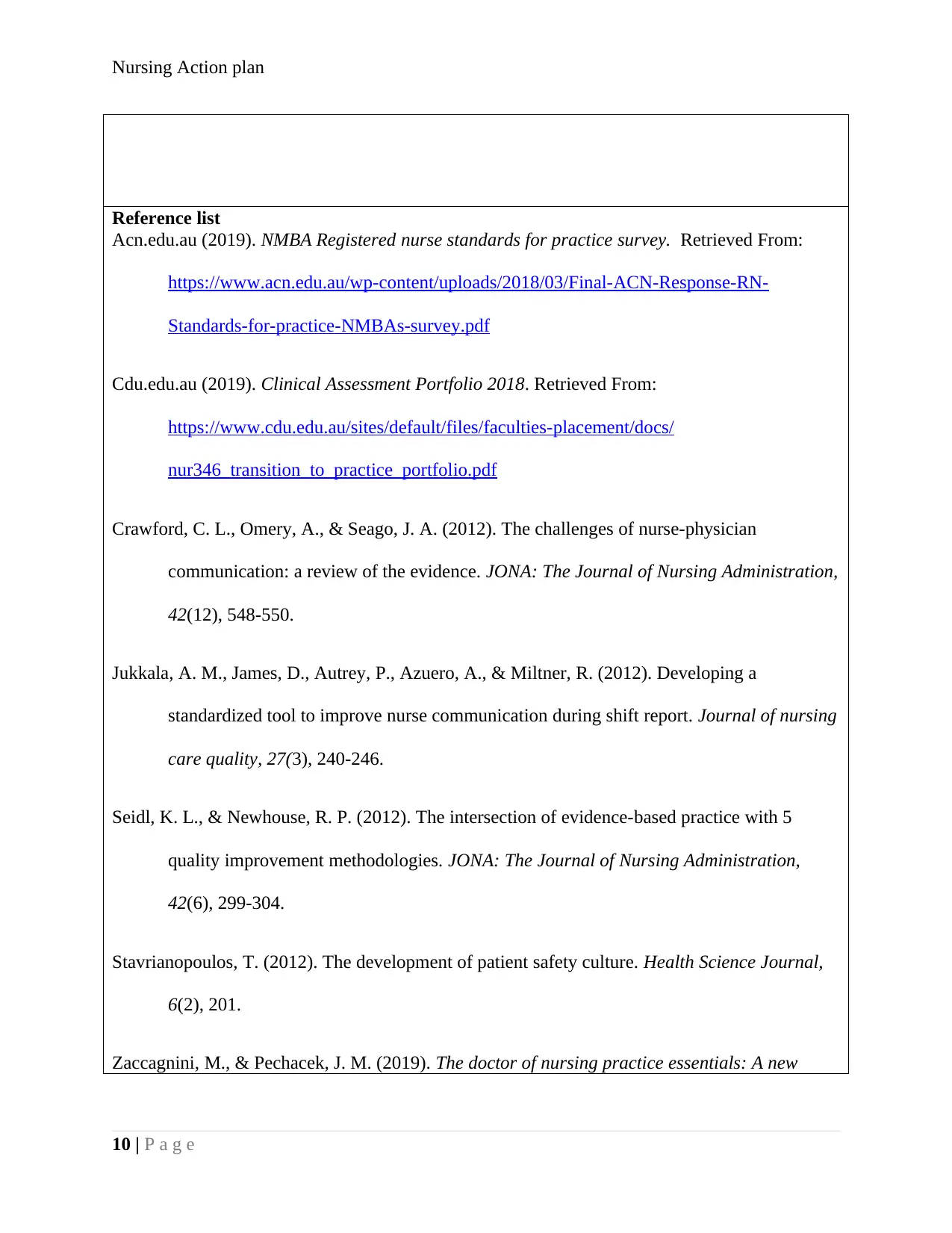
Nursing Action plan
Reference list
Acn.edu.au (2019). NMBA Registered nurse standards for practice survey. Retrieved From:
https://www.acn.edu.au/wp-content/uploads/2018/03/Final-ACN-Response-RN-
Standards-for-practice-NMBAs-survey.pdf
Cdu.edu.au (2019). Clinical Assessment Portfolio 2018. Retrieved From:
https://www.cdu.edu.au/sites/default/files/faculties-placement/docs/
nur346_transition_to_practice_portfolio.pdf
Crawford, C. L., Omery, A., & Seago, J. A. (2012). The challenges of nurse-physician
communication: a review of the evidence. JONA: The Journal of Nursing Administration,
42(12), 548-550.
Jukkala, A. M., James, D., Autrey, P., Azuero, A., & Miltner, R. (2012). Developing a
standardized tool to improve nurse communication during shift report. Journal of nursing
care quality, 27(3), 240-246.
Seidl, K. L., & Newhouse, R. P. (2012). The intersection of evidence-based practice with 5
quality improvement methodologies. JONA: The Journal of Nursing Administration,
42(6), 299-304.
Stavrianopoulos, T. (2012). The development of patient safety culture. Health Science Journal,
6(2), 201.
Zaccagnini, M., & Pechacek, J. M. (2019). The doctor of nursing practice essentials: A new
10 | P a g e
Reference list
Acn.edu.au (2019). NMBA Registered nurse standards for practice survey. Retrieved From:
https://www.acn.edu.au/wp-content/uploads/2018/03/Final-ACN-Response-RN-
Standards-for-practice-NMBAs-survey.pdf
Cdu.edu.au (2019). Clinical Assessment Portfolio 2018. Retrieved From:
https://www.cdu.edu.au/sites/default/files/faculties-placement/docs/
nur346_transition_to_practice_portfolio.pdf
Crawford, C. L., Omery, A., & Seago, J. A. (2012). The challenges of nurse-physician
communication: a review of the evidence. JONA: The Journal of Nursing Administration,
42(12), 548-550.
Jukkala, A. M., James, D., Autrey, P., Azuero, A., & Miltner, R. (2012). Developing a
standardized tool to improve nurse communication during shift report. Journal of nursing
care quality, 27(3), 240-246.
Seidl, K. L., & Newhouse, R. P. (2012). The intersection of evidence-based practice with 5
quality improvement methodologies. JONA: The Journal of Nursing Administration,
42(6), 299-304.
Stavrianopoulos, T. (2012). The development of patient safety culture. Health Science Journal,
6(2), 201.
Zaccagnini, M., & Pechacek, J. M. (2019). The doctor of nursing practice essentials: A new
10 | P a g e
Paraphrase This Document
Need a fresh take? Get an instant paraphrase of this document with our AI Paraphraser

Nursing Action plan
model for advanced practice nursing. US: Jones & Bartlett Publishers.
Action plan 3 for improvement of “Provides safe, appropriate and responsive quality
nursing practice”
Goal: To offer the patients safe, errorless, relevant and responsive nursing service.
Specific
Quality practices to be implemented to attain the
agreed outcomes to the needs of the patients.
Measurable
The most important step is to give safe and error-
free service to the patients for timely healing and
reduce the chances of further infection.
Achievable
Appropriate guidelines, regulations and regular
training to the nurses to understand the change in
need of the patients.
Relevant
The satisfied patients and the family members will
refer to the services to others in need, thereby
bringing more individuals to the healthcare unit.
However, negligence on the part of nurses will cost
heavily in loss of customers.
Time-Bound Within 8 months.
11 | P a g e
model for advanced practice nursing. US: Jones & Bartlett Publishers.
Action plan 3 for improvement of “Provides safe, appropriate and responsive quality
nursing practice”
Goal: To offer the patients safe, errorless, relevant and responsive nursing service.
Specific
Quality practices to be implemented to attain the
agreed outcomes to the needs of the patients.
Measurable
The most important step is to give safe and error-
free service to the patients for timely healing and
reduce the chances of further infection.
Achievable
Appropriate guidelines, regulations and regular
training to the nurses to understand the change in
need of the patients.
Relevant
The satisfied patients and the family members will
refer to the services to others in need, thereby
bringing more individuals to the healthcare unit.
However, negligence on the part of nurses will cost
heavily in loss of customers.
Time-Bound Within 8 months.
11 | P a g e

Nursing Action plan
Objective
To give safe, appropriate and fast nursing services to all the patients in the hospital.
Strategies
Accurate utilization of prophylaxis to reduce the chances of venous thromboembolism in
individuals at risk.
The health care professionals and practitioners must double-check the medications
prescribed before administering it. It will reduce the chances of wrong administration of
drugs and prevent potential harm caused due to it (The Royal College of Nursing, 2019).
Authorized experts must do double-checking of medicines (Sedgwick, Grigg & Dersch,
2014).
The health problems must be documented, recorded and reported on time to time basis.
Nursing problems should be formulated and backed by evidences. It will help in
assessing the patients in the future (Durey, Wynaden, Thompson, Davidson, Bessarab &
Katzenellenbogen, 2012).
Ensure that patients are monitored continuously and ECGs are performed timely and
collect the disease evidence to offer relevant clinical rationale and intervention in the
future.
Collaborative work should be encouraged by the team members and allied clinical staff.
Ensure that entire patient details is available for the nurses to give error-free and reliable
diagnoses.
Continuous supervision and assessment will help in identifying the gaps in the nursing
practices and training assessment needs must be conducted.
Further, skills training, knowledge training and specialized training must be imparted at
regular intervals to empower the nurses in order to make the individuals equipped enough
12 | P a g e
Objective
To give safe, appropriate and fast nursing services to all the patients in the hospital.
Strategies
Accurate utilization of prophylaxis to reduce the chances of venous thromboembolism in
individuals at risk.
The health care professionals and practitioners must double-check the medications
prescribed before administering it. It will reduce the chances of wrong administration of
drugs and prevent potential harm caused due to it (The Royal College of Nursing, 2019).
Authorized experts must do double-checking of medicines (Sedgwick, Grigg & Dersch,
2014).
The health problems must be documented, recorded and reported on time to time basis.
Nursing problems should be formulated and backed by evidences. It will help in
assessing the patients in the future (Durey, Wynaden, Thompson, Davidson, Bessarab &
Katzenellenbogen, 2012).
Ensure that patients are monitored continuously and ECGs are performed timely and
collect the disease evidence to offer relevant clinical rationale and intervention in the
future.
Collaborative work should be encouraged by the team members and allied clinical staff.
Ensure that entire patient details is available for the nurses to give error-free and reliable
diagnoses.
Continuous supervision and assessment will help in identifying the gaps in the nursing
practices and training assessment needs must be conducted.
Further, skills training, knowledge training and specialized training must be imparted at
regular intervals to empower the nurses in order to make the individuals equipped enough
12 | P a g e
⊘ This is a preview!⊘
Do you want full access?
Subscribe today to unlock all pages.

Trusted by 1+ million students worldwide
1 out of 15
Related Documents
Your All-in-One AI-Powered Toolkit for Academic Success.
+13062052269
info@desklib.com
Available 24*7 on WhatsApp / Email
![[object Object]](/_next/static/media/star-bottom.7253800d.svg)
Unlock your academic potential
Copyright © 2020–2025 A2Z Services. All Rights Reserved. Developed and managed by ZUCOL.





